The post The Ultimate Land Rover Defender Camping Setup appeared first on The Blonde Abroad.
from The Blonde Abroad https://ift.tt/3e9aYRf
The post The Ultimate Land Rover Defender Camping Setup appeared first on The Blonde Abroad.
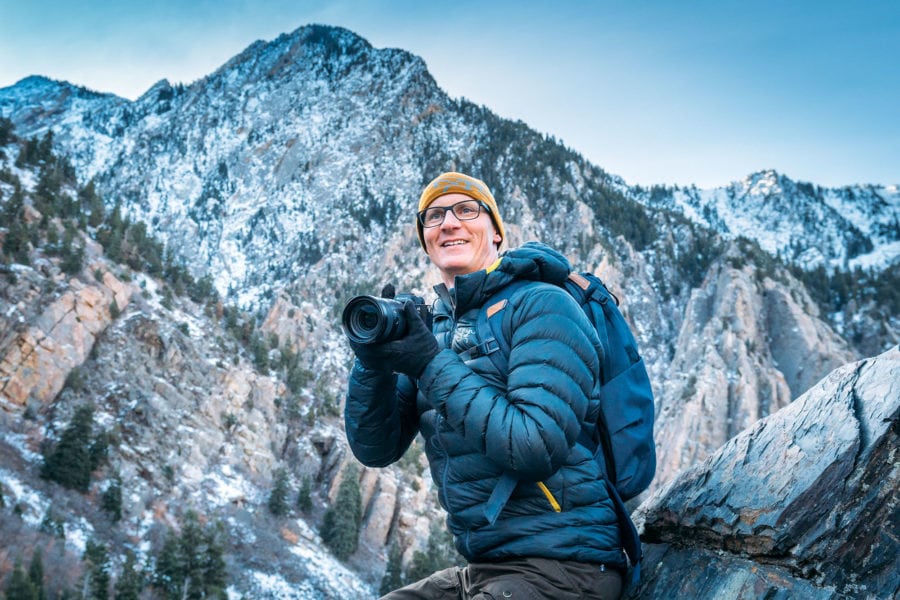
Turning freelance photography into a paid profession is a dream for many people. While difficult, it’s definitely possible. Here’s how to make money as a successful photographer.
I’ve been working as a professional freelance photographer for the past 10-years or so. Getting paid to travel the world shooting photos of exotic destinations and licensing my images to different organizations is pretty awesome.
I’ve even sold some images to National Geographic!
Freelance photography is a profession that’s constantly changing, and to make it work you need to stay on top of all the latest trends — like post-processing techniques, social media skills, networking, and successful business models.
In this guide I’m going to share helpful tips for how to become a freelance photographer and actually make money from your photography.
These are suggestions based on what I’ve learned over the years, along with a few wisdom nuggets from some of my favorite travel & adventure photographers.
Freelance photography is providing photos to clients and licensing them for a fee, or working as a self-employed freelance photographer. You can get hired in advance for specific projects, or shoot the photos first — selling them later.
There are many different types of professional photography jobs out there, like travel photography, landscape photography, commercial photography, portraits, wedding photography, or fine-art photography.
In this guide I’m going to focus on a mix of travel, adventure, commercial, and editorial photography. The quintessential dream photography jobs. However the advice can be relevant for other kinds of photography too.
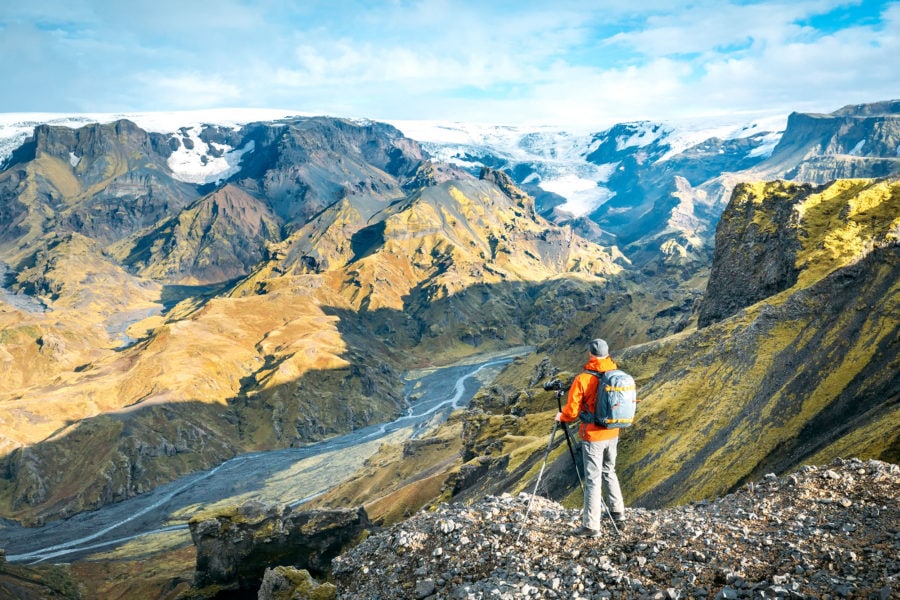
The life of a professional freelance photographer can be hard. Especially in the beginning of your career. Personally, it took me a few years to earn any money at all. And that’s pretty common.
You’ll often work alone, for long hours, with very little stability (or income). It is a long-term commitment, with no guarantee of success, and many people eventually give up.
Pursuing a freelance photography career is definitely not for everyone…
That said, if you DO find a way to make it work, it’s one of the coolest jobs out there. And the longer you do it, the more you learn, and the more money you can make.
Even after many years working my butt off, for little pay, and occasionally questioning my life choices along the way, I wouldn’t trade working as a freelance travel photographer for anything else!
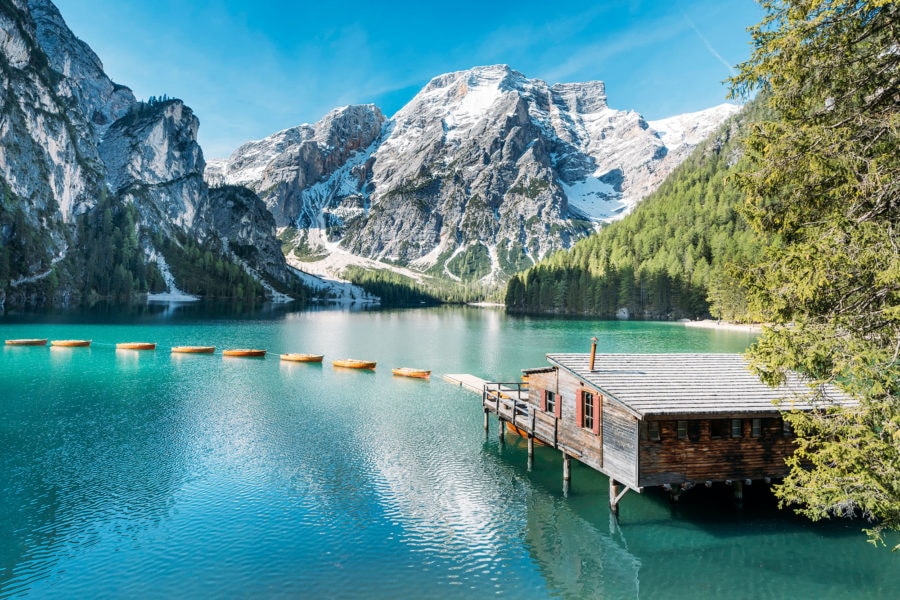

Never stop learning! I get many emails from people asking for tips on how to make money from photography, and after viewing their work, usually my top piece of advice is — to get better at photography.
Which may sound kind of harsh, but often true.
Hey, I’ll be the first to tell you I’m not the best photographer out there. I’m constantly learning new things from others, investing both time & money into training to make that happen.
Owning a nice camera does not make you a great photographer. Practice, experience, and skill do. There is ALWAYS room to get better at composition, lighting, post-processing techniques, creativity, location scouting, and more.
For example, shooting photos is easy, but meticulously planning to be at the right place, at the right time, is far more difficult and requires more patience.
Are you willing to camp out in a cold desert waiting for the milky way to appear in just the right spot? Are you willing to spend days waiting for good weather to get the perfect shot?
So before you start pitching brands for projects, ensure your photography will truly stand out from all the other freelance photographers doing the same. You don’t have to be the best, but you do need to hold your own among other pros.
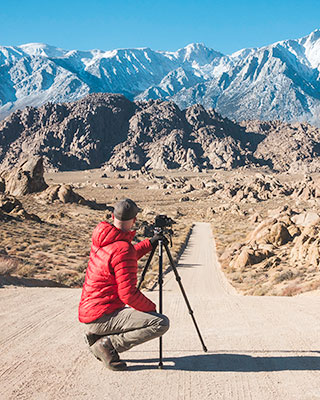
Want to improve your photography? Learning from other photographers is the fastest way. Check out my favorite online photography classes & tutorials!
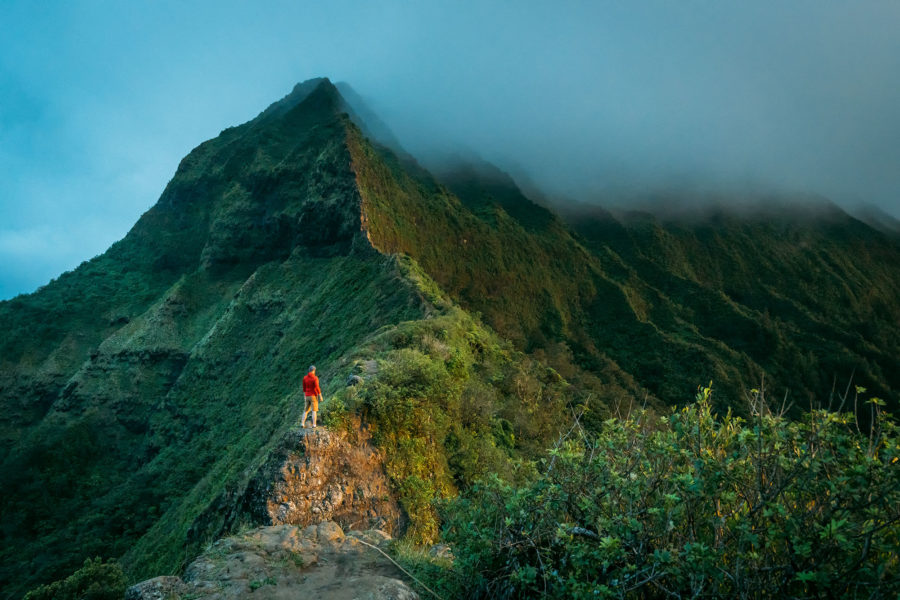

If you’re shooting the same kinds of photos as everyone else, your work won’t stand out and you’ll get lost in the sea of people just trying to copy the most popular photos on Instagram.
While it won’t happen overnight, you need to develop a personal style of photography. Something people will remember you for. Focus on a specialty, like ariel drone photography, or outdoor sports photography, or even fantasy portraits.
While you can certainly practice other kinds of photography, you should try to keep your portfolio narrow and focused, to make it easy to “define” your style. So when someone is looking for an underwater photographer, they can see right away that’s your specialty.
Editing and processing your photos in a certain style can help with this too.
Some clients are looking for realistic images, others want a more dreamy and ephemeral vibe. Just because you CAN do it all, doesn’t mean you should.
The photographers who get regular work often do so because they become known for a particular style.


I’m sure you already have accounts with Instagram, Facebook, maybe 500px too — but do you have an actual photography website & blog yet?
A professional website is what many potential clients will want to see.
Put together a strong portfolio of your best shots (more on that later) and make sure it’s easy to navigate. Buy an actual domain name — using your name or company name if possible.
Include a blog section on the website, where you can post updates about your latest photography projects, photo tips, philosophy on life, whatever. The blog will help people get to know you, and can even attract new clients.
If you want to start a blog, I’d recommend a self-hosted WordPress site. If you want to create a beautiful online photography portfolio of your work, and sell your own prints, I’d also get an account with SmugMug.
This is my personal setup, and it’s worked very well for many years! In fact, I’ve sold many images to companies who’ve discovered my work either on my blog, or on my SmugMug account after a simple Google search for a specific type of image.
Get your work out there online, learn about keywords and SEO, make sure it’s easy for others to find your images — and they eventually will.


One of the most important things you can do as a photographer is invest in personal projects to help build a portfolio of work that will get you noticed by clients. A portfolio is simply a collection of your best photos.
Want to become a travel photographer? Well you’ll probably need to spend your own money on travel to get some amazing shots for your portfolio, which you can then use to pitch travel destinations or travel brands.
Want to work with backpack, tent, and other outdoor gear brands? You’ll need to get out into the mountains and shoot some product photography examples for your portfolio which will match what these kinds of brands are looking for.
There are no shortcuts here. You need to spend money & time building a strong portfolio of work that will “sell” your services to potential clients later.
Your portfolio can be based online, but I highly recommend you also create a PDF version which is easily emailed or printed out and passed around an office.
You can think of a media kit as the story of you and your work, in PDF form. It contains elements of a portfolio, but with more information that will help clients decide whether to hire you or not.
It’s kind of like a pitch deck (which I’ll describe a bit later), but rather than pitching a specific project, you’re simply pitching yourself.
Generally a media kit starts with an introduction about you, sharing your personal mission statement, a healthy selection of images from your portfolio, and maybe some examples of past clients if applicable — plus contact details of course.
If you have a strong social media presence, many media kits will mention things like follower numbers across different social media platforms too.
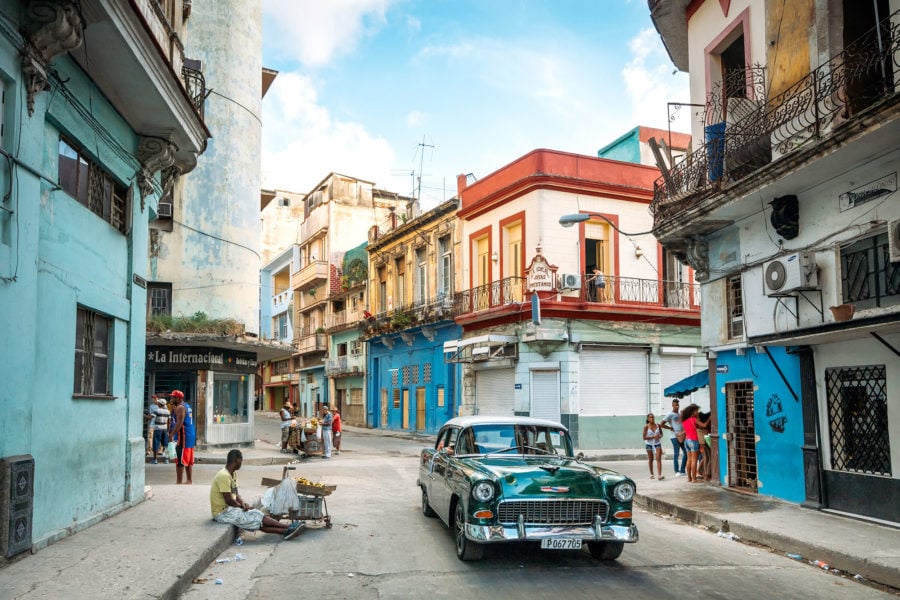

Share your work regularly on social media. Daily if possible. Create & share. Create & share. Rinse & repeat.
Share your work consistently, both for the encouragement & praise you receive from others, as well as to flood the market with your art.
You never know what photo or video will resonate with people, or what will viral on social media. Or when some brand will happen to be searching for a new freelance photographer to hire.
To maximize your chances of discovery, you need to constantly create — and share. Over and over again. They don’t call us “creators” for nothing!
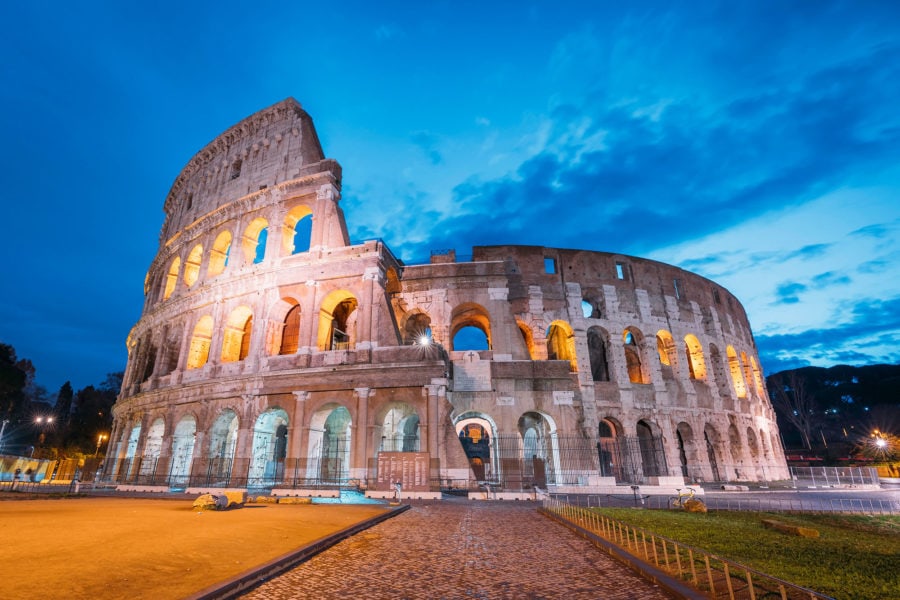

The truth about becoming a freelance photographer is that you need to put yourself out there to find jobs. Shooting photos is often the easy part!
Networking is the very important business skill that will determine if you make money from your photography or not. Make a list of the people, brands, and agencies that you’d like to work with, and reach out.
Try starting with smaller brands first.
Study the brand and its values. Interact with their online content for a while in a meaningful way. Then, cold call them on the phone, send an email, or reach out with a direct message on social media (Instagram, Twitter, LinkedIn).
Tell them you like what they do. Don’t be creepy, annoying, or pushy. Then find out if there’s a way you can work together on a future project. Attach that media kit & portfolio you just put together!
Other than individual brands, you may want to try to reach out to “agencies” too. An agency is in charge of managing the marketing for many different brands, often in a particular category. There is potential for much more work if you can build a relationship with an agency.
You may hear a lot of “we’re not looking for anyone right now” at first. Never take it personally, and just remember this is a numbers game.
Some of the most successful freelance photographers are the ones who work the hardest at pitching & networking — day in, and day out.
A pitch deck is different from your media kit or portfolio mentioned earlier. The purpose of a pitch deck is to “pitch” a specific project idea to a brand.
Some companies will come to you with projects, while others might want you to pitch them a new idea. Learning how to prepare a professional and convincing pitch deck for either of these situations is an art-form in itself.
A convincing pitch deck PDF usually contains the following:
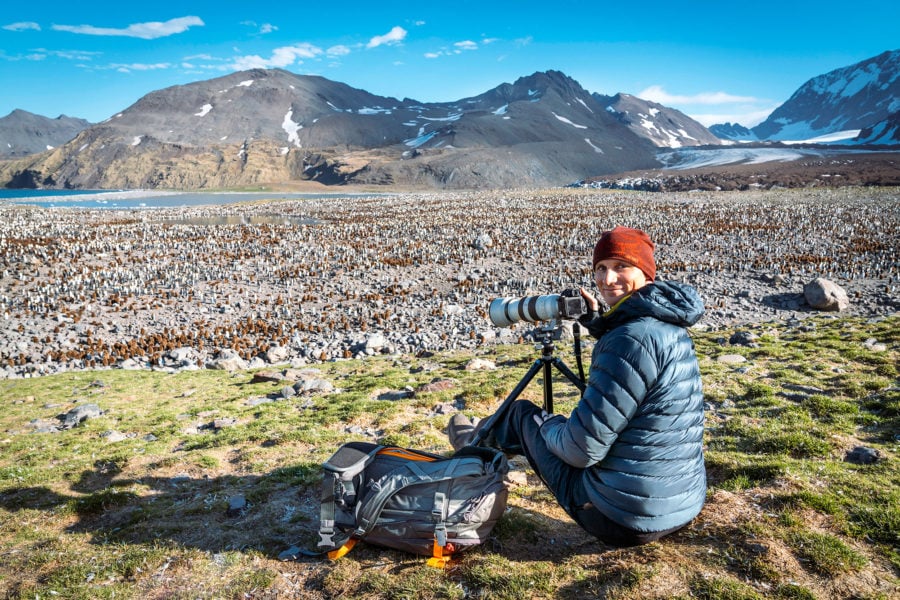
One thing I’ve learned after working for the last 10-years as a freelance travel photographer is that to earn decent money in this business, you really need to diversify your photography income sources.
This will both increase your earning potential, as well as hedge against changes in the market (worldwide pandemics, anyone?). So if one source of income suddenly disappears, you aren’t completely screwed!
Here are the most popular ways to make money from photography.
Editorial photography basically means your images are being used in newspapers and magazines to accompany articles about a certain subject. For example, a photo of a camel in the desert published in a travel magazine feature about Morocco.
To sell editorial photos, you generally need to work with a magazine editor who can tell you what kinds of images they are looking for in an upcoming issue of the magazine. This requires networking and sending your portfolio to many different magazines on a regular basis.
Commercial photography is when your images are being used by brands for marketing and advertising purposes. It pays much more than editorial photography, but usually requires that you have already built up a name for yourself as a photographer, often through editorial work.
Some examples might include shooting photos for a clothing brand, a car company, or even the tourism board for a country.
Rates for commercial photography are negotiable, and can be based on how many images they license from you, for what use, and for how long. Alternatively, many commercial photography projects might pay a day-rate for your time that also gives them a blanket license to any images you create during the project.
Licensing images you’ve already shot through stock photography sites or rights management companies is one way freelance photographers can earn money.
Many smaller brands don’t have huge budgets to hire photographers for dedicated projects, so they buy temporary photo licenses for work that’s already been created.
Photographers upload their photos to these sites, tag and organize them, then random companies search for images to license.
If you’re able to build up a large portfolio of the kinds of images that are sought after, you can make “passive” income month after month selling your old images.
There are two main types of stock photography companies out there. Rights Managed Stock Agencies and Microstock Sites.
Rights Managed Stock Agencies pay photographers better, because the quality of the work is generally higher, the clients are pickier, and licenses are stricter/more exclusive.
Microstock Websites might only pay you $0.50 for a Royalty Free photo, but hundreds of different websites could be buying and using that same image.
A relatively new phenomenon is the launch of post licensing companies that proactively search for your images already being used illegally online, and contacting the copyright infringers on your behalf to demand a licensing fee.
For many photographers, chasing after people who are stealing their images online just isn’t worth the effort. However these new companies, armed with teams of actual lawyers and image tracking software, are MUCH more effective.
They take a large cut of course, but they also do most of the work for you. Here are some examples:
Selling photo prints, coffee table books, calendars, and other “merch” that feature your photography can be a solid way to earn income for many freelance photographers.
Prints can be especially lucrative if you have a strong online following, and it’s also a great way to help raise money for charities and local organizations that you like.
For example, with the ability to set my own prices on SmugMug, I can ensure I have enough profit to also give 10% of any print sales to the National Parks Foundation. Or launch regular free print giveaways to my social media followers, just for fun.
Lightroom Presets are post-processing settings that many photographers use to obtain a certain “look” with their photos. For people who are new to editing photos using software, using presets can help them easily improve their photos with cool colors, tones, and other adjustments. Many photographers develop and sell their own presets to their followers, which can be a decent source of income.
There is far more to good photography and editing than most people think, that’s why getting into the education space and teaching other would-be photographers how to improve their images can be a good way to earn extra income.
Online photography classes allow a photographer to share their knowledge with many more people than trying to do it in person.
Some people charge fees for their tutorials, others provide the training for free on platforms like YouTube and then earn money through the advertising.
Leading in-person photography workshops can be an excellent source of income if you have a decent following online. Getting paid to hang out with other people while teaching them your photography techniques in exotic locations around the world can be a lot of fun too!
To launch a successful photography workshop, it helps to have already built up a following of people who love your work, and who are ready to spend money learning from you in person.
What’s the most common question that every photographer gets? What kind of camera do you use!
Why not recommend your favorite gear to others, and get paid for it?
I make a decent portion of my income from affiliate marketing. Photography gear guides, tripod comparisons, and even photography tutorials. I’m not promoting stuff I don’t use or believe in, only products that I actually love.
You can share these affiliate links on YouTube, Instagram, or your own photography blog which will generate a small commission off each sale.
The more useful your content is, the more it gets shared, and the more people will click on your links. When more people click your links, the more you earn. Everyone wins!
Lots of companies offer affiliate marketing partnerships. Some good photography related ones include:


How much should you charge for your photography? Well, there are many factors at play here. Editorial photography? Commercial photography? Print sales? Image use? Licensing time-period? What is your time worth to you? What size problem are you solving for the client?
In general, there is a basic path that many photographers end up following:
I hesitate mentioning working for exposure, because many professional photographers might disagree, but the reality is many of us started by giving images away for little or no money to build up a portfolio of work to show off.
I’ll give you an example. I once let GoPro use an image I shot of a shark underwater on their social media channels during Shark Week in exchange for just a photo credit/link. The buzz around that photo ended up sending me a few thousand new followers on social media, at a time when I didn’t have many.
These days, my strong social media presence helps me attract new photography clients for paying gigs, so I really don’t regret giving some companies free photos all those years ago, when I was hungry to build a name for myself. This is a personal choice and not every photographer will agree with this route.
Don’t be afraid to say no. Sick of giving images away for “exposure”? Just say no and move on. There will be other companies who are willing to pay for your images. Along those same lines, if you send over a quote for a job, and they client says yes right away, you probably should have asked for more!
If you do send a quote, and the client comes back with a lower amount they won’t budge on, the other tool you have at your disposal is to lower the deliverables they’ll receive. If they’re taking money away, you get to take something away too.
EXAMPLES:
Note that those examples only really work for commercial photography, as editorial photography often has set rates, and there isn’t a ton of negotiation that goes on.
The art of negotiation in freelance photography is a huge topic, one I can’t cover completely here, but if you’d like to learn more I recommend reading the book: Getting To Yes: Negotiating Agreement Without Giving In


Many people love the idea of making a living with their photography. But eventually you realize just how many other freelance photographers are out there with those same dreams of success.
It’s a crowded field!
Just know that there are many levels of success in freelance photography. For some, getting their first paid gig is a huge success. For others, only the cover of a famous magazine will do.
You have to ask yourself — is photography just going to be a hobby? Or are you ready to treat it like a professional career (with all the work that entails)?
When was the last time you contemplated the ROI (return on investment) of a new gear purchase? Do you have a marketing/PR budget set aside for your photography business?
It’s easy to compare yourself to other “successful” photographers, while not truly understanding the blood, sweat, and tears they’ve put into this industry to get to where they are today.
Years of experience. Hundreds of hours of networking. Thousands (or tens-of-thousands) of dollars spent building a portfolio. The logistics & work involved setting up a functioning business.
It’s not impossible to make a living as a freelance photographer these days, but you also need to manage your expectations for what success looks like… and how long it might take to achieve.
I hope you enjoyed my guide on becoming a freelance photographer! Hopefully you found it useful. Here are a few more photography related articles that I recommend you read next:
Have any questions about becoming a professional photographer? Anything I missed? Drop me a message in the comments below!
This is a post from The Expert Vagabond adventure blog.
The post The Ultimate 3-Day Palm Springs Itinerary appeared first on The Blonde Abroad.
The post The Best Boutique Hotels in California appeared first on The Blonde Abroad.

From ancient architecture to tasty street food, Europe’s hottest city has much to offer curious travelers. Here are some of the best activities and things to do in Athens, Greece!
Athens is the capital of Greece and dedicated to the goddess Athena. It’s often called the ‘birthplace of democracy’ and the ‘Cradle of Civilization’ because it was also home to the Platonic Academy and the Lyceum of Aristotle.
With a recorded history dating back 3400 years, Athens (also called Athenai) has many archaeological wonders worth visiting.
Replete with temples, ancient ruins, and statues of deities, Athens is now a mix of modern buildings with the older architectural marvels.
Aside from the history and architecture the city is known for, there are many other fun things to do in Athens that most people miss…
If you’re planning to spend some time in Athens, I wanted to recommend some of my favorite fun and unusual things to do, no matter what time of year you visit.
Starting in May, Greece is allowing travelers to visit, including American tourists. You must either have proof of your COVID-19 vaccination(s), or present a negative PCR test within 72 hours of your flight.
Hotels, attractions, and private tours are open with new health & safety protocols in place, and you still have to follow certain guidelines (like wearing masks indoors).
You can find the latest updates on traveling to Greece here.
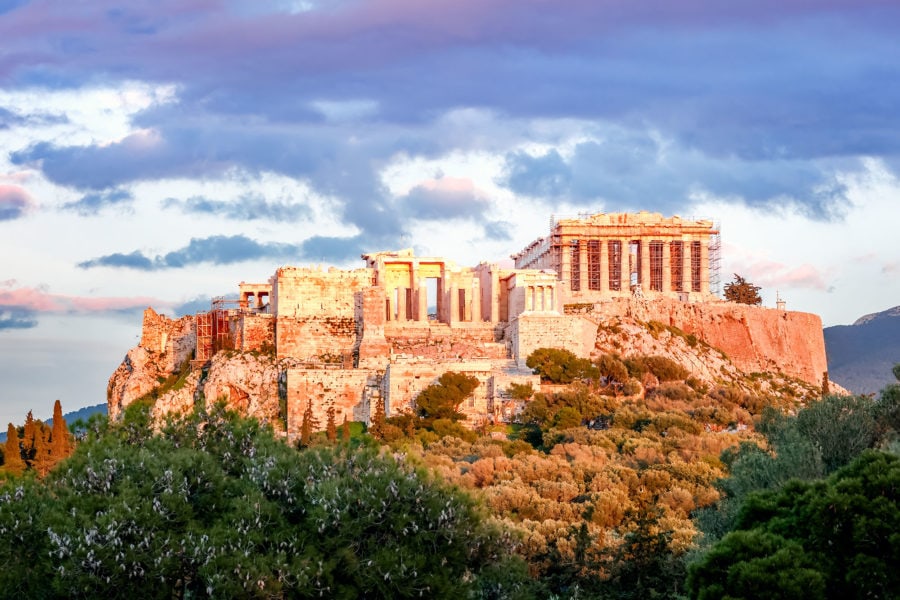
You can’t start a visit to Greece without hiking up to visit the Acropolis. As one of the most important Athens locations, as well as a World Heritage Site, this fortified citadel perched on a hill above the city stands out as a testament to Greek wisdom and culture.
The Acropolis holds many different ancient ruins, like the world-famous Parthenon temple, dedicated to the Greek goddess Athena.
Walk through the Propylaea, the ancient Gateway to Athens. Imagine a play at the Theatre of Dionysius. Walk past the Stoa of Eumene, and see the healing temples called Asclepeion. Visit the temple of Athena Nike, and gaze in wonder at the Erechtheion (Erectheum).
Plan to spend at least a few hours exploring the Acropolis, if not a full half-day. There’s a lot of hiking up stairs and on worn-down slippery rocks. You’ll get a workout!
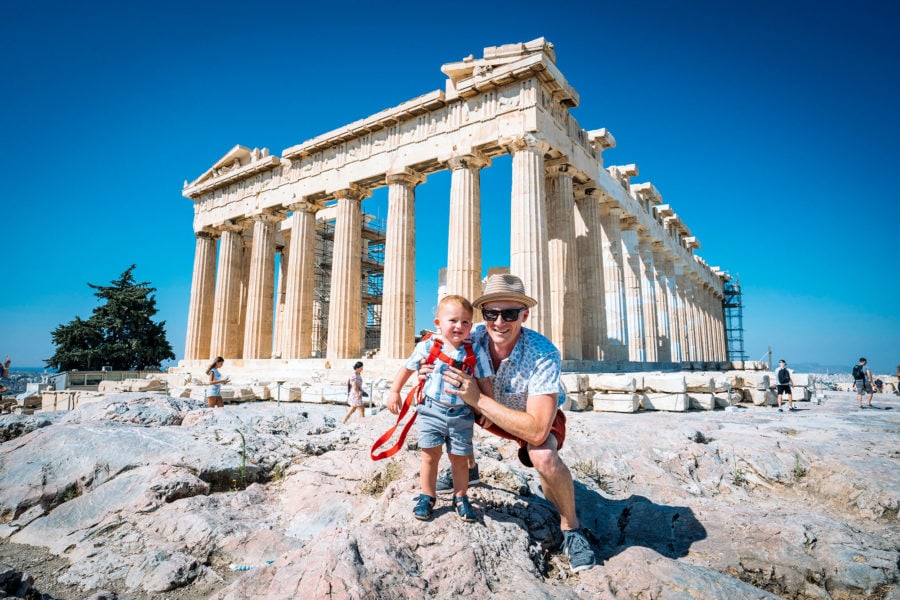
While part of the Acropolis complex, the Parthenon deserves a specific mention. Built in 447 BCE on the hill of the Acropolis, with Doric marble columns that thinned towards to top — showcasing the architectural marvels of ancient Greece.
Dedicated to goddess Athena, these ruins are a must-visit during the day; and seen from across the city the magnificent columns look spectacular lit up at night at night.
It can get crowded up there, so I recommend going first thing in the morning when the Acropolis opens, or during the last few hours before they close!
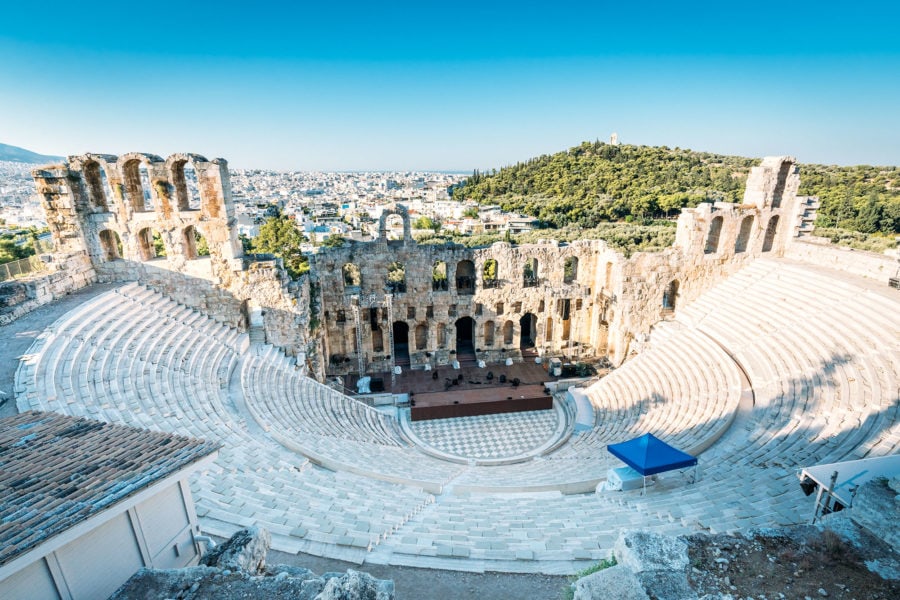
The Odeon of Herodes Atticus is an ancient theater perched on the South Western slope of the Acropolis in Athens. Frank Sinatra, Nana Mouskouri, Pavarotti, and Andrea Bocelli have all performed here!
Built by Herodes Atticus in 161 AD, in memory of his dead wife, the steep-sloped Odeon had a cedar roof and seated 5000 for music concerts till it was destroyed in 267 AD.
It has been used as a venue for many popular concerts since it was restored in the 1950s. If you happen to be visiting Athens when a concert is going on here, I highly recommend you go!
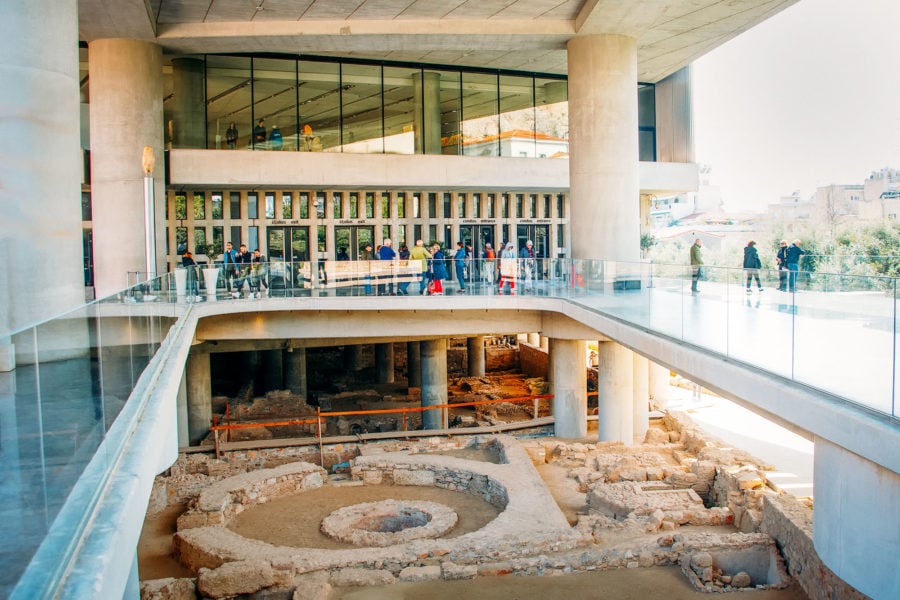
Built to house ancient artifacts from the Acropolis ruins, the Acropolis Museum on the Southern slopes of the Acropolis opened in 2009. Just a short 400 meter walk from the Parthenon, a visit to the museum can be combined with a visit to the Acropolis.
The museum is home to over 4250 objects and replaces the older museum that was housed atop the Acropolis from 1874 to the 1950s.
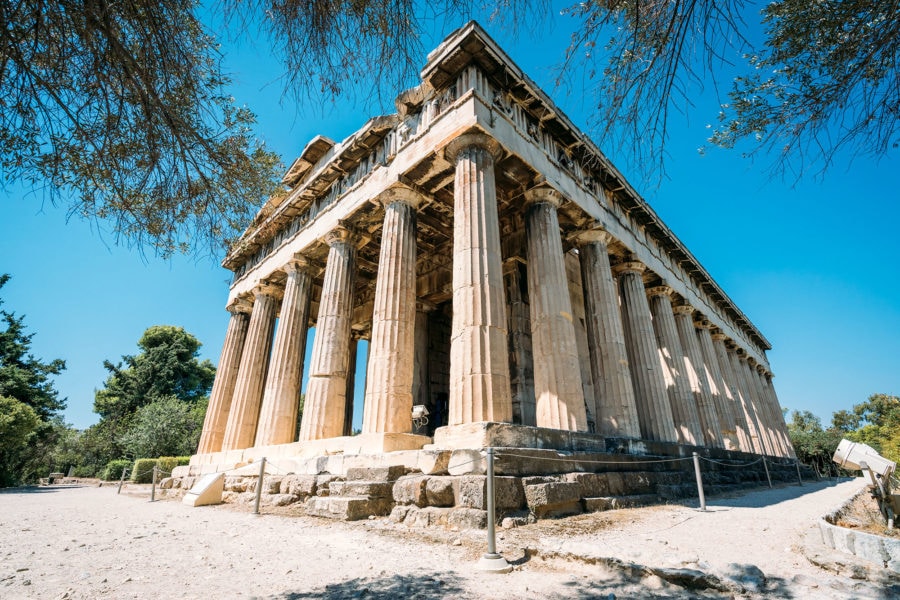
The Central Square in ancient Greek cities, the Agora was a gathering place for citizens to discuss affairs of state, marriages, and partake in religious rituals. Over the course of time the Agora also came to be used a marketplace selling goods, food, pottery, and religious artifacts.
Next to the Athenian Agora, you’ll also find the Temple of Hephaestus which was very well-preserved compared to other Greek temples. This Doric temple was built by The Hephaisteion Master under the aegis of Pericles between 449 to 415 BC to honor Hephaestus, the god of craftsmanship, fire and metal work.
The Stoa, another good site nearby, houses the Museum of Ancient Agora, that is home to Athenian, Byzantine and Turkish artifacts.
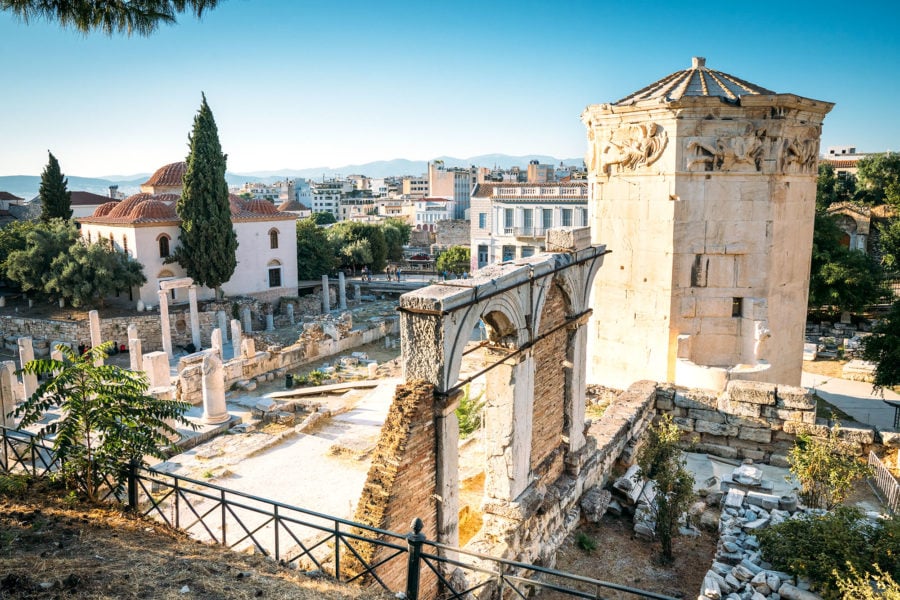
Located to the East of the Ancient Agora, the Roman Agora was built much later and encroached on the site of the older one. The entrance to it was through the still standing Gate of Athena Archegetis. The 17th century Fethiye Mosque is located in the Northern end of the agora.
The agora is also home to the 12-meter tall Horologion of Andronikos Kyrrhestes, also known as the Tower of the Winds, which was probably the first meteorological station in the world. Also called Areides, the tower features a water clock, different sundials, and once also included a Triton weather-vane.
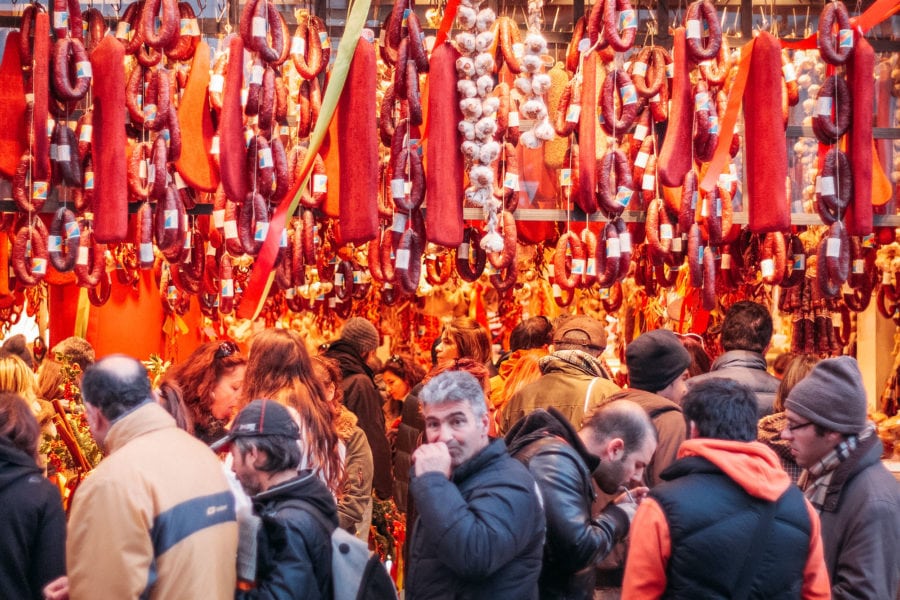
The Varvakios Central Market in Athens (not to be confused with Central market where food trucks gather) is also called the Varvakios Agora or Dimotiki Agora. If you love public markets, this is where you’ll find fish, meat, produce, street food, souvenirs, and whole stores dedicated to olives or spices.
Because of the variety of goods, low prices, and freshness, this is where many local restaurants get their ingredients. The fish market alone serves up to 5,000 customers every day and employs more than 400 people!
HOURS: Varvakios market is open between 7am and 6pm every day but Sundays.

The Panathenaic Stadium was built to host the first modern Olympic Games in 1896, on the same site as an even older ancient stadium where nude male athletes competed in track events.
While the older stadium built in 335 BC could hold 60,000 spectators, the modern Olympic Stadium you see today can hold 45,000 spectators on 47 tiers.
We ran around the track with our son Dylan, pretending we were at the Olympics. You can climb to the top of the stadium for an even better view of how massive it is, and of course there is a tri-level medal podium where you can pose for photos.
You can also go inside the stadium to visit a little museum of Olympic history, complete with the torches used in past games.
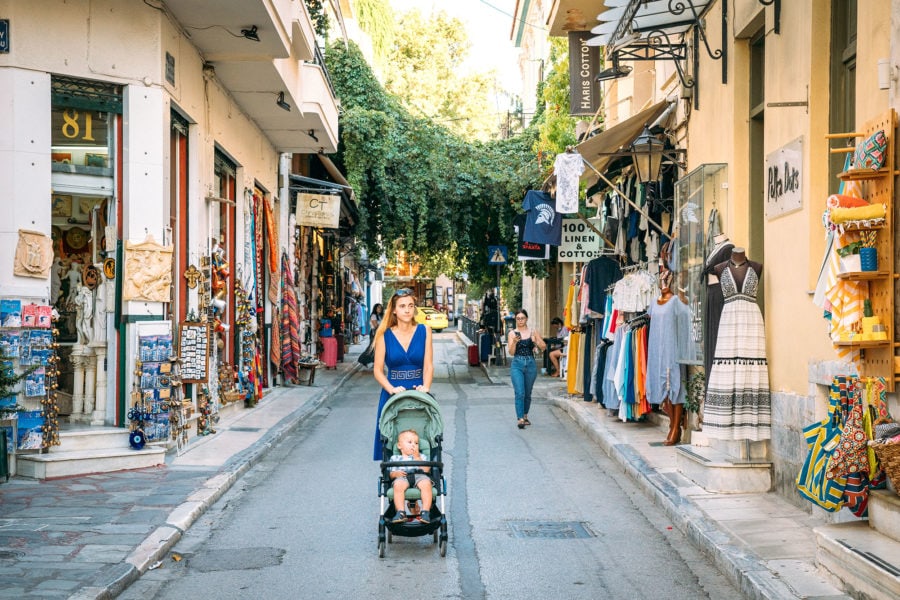
Lined with colorfully painted old houses, the Plaka quarter of Athens is home to small taverns where you can taste some authentic Greek food. Walk through the winding alleys and visit the Library of Hadrian, Kapnikaréa Church, Metamórfosis Church, or spend time shopping at popular stores on Ermou Street.
Visit the nearby Anafiotika quarter to take pictures, or enjoy a drink while soaking in the vibes at the famous Restaurant Staircase on Mnisikleous Street.
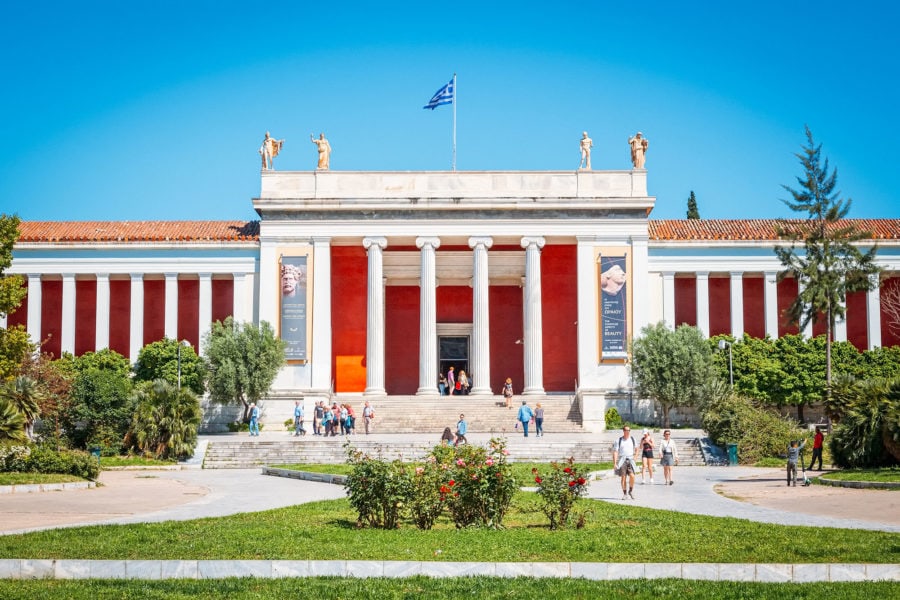
Greece’s largest archaeological museum, the National Archaeological Museum of Athens was set up in the 19th century. Housed in a Neo-classical building designed by L. Lange, it houses over 11,000 artifacts and 5 permanent collections.
Prehistoric antiquities from the Mycenaean, Neolithic, and Cycladic areas, Greek ceramics from 11th century BC, Egyptian antiquues dating back to 5000 BC, marble Cycladic figurines, gold artifacts from the Mycenaean period, there’s a lot to see here!
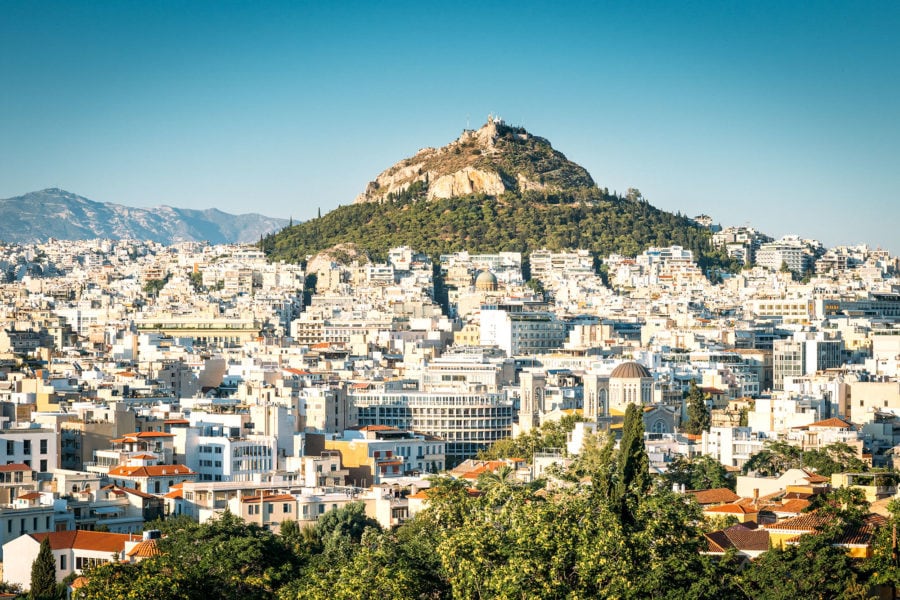
A cretaceous limestone hill towering over Athens, Lykavittos or Mount Lycabettus rises 300 m above sea level. Covered with pine trees, the hill is perfect for a hike to the top, and rewards the visitor with picture perfect views of Athens.
If you’re too lazy to hike, ride the Lycabettus Funicular to the top, and spend time at the restaurant after visiting the Chapel of St. George.
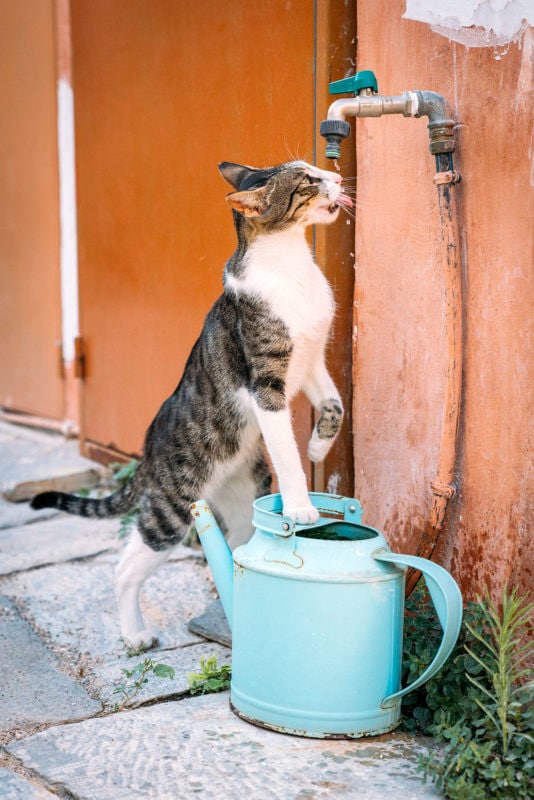
Much like Istanbul in Turkey — Athens is full of stray cats. Local shop owners and other residents kind of “adopt” them by putting out food & water, but the cats are wild & free to roam the city.
As huge cat fans, this was a pleasant surprise! We were always keeping our eyes out for strays, and even bought some dry cat food to give them as we wandered around the city.
One of the best places to find stray cats is around the Choragic Monument of Lysicrates in the Plaka neighborhood.
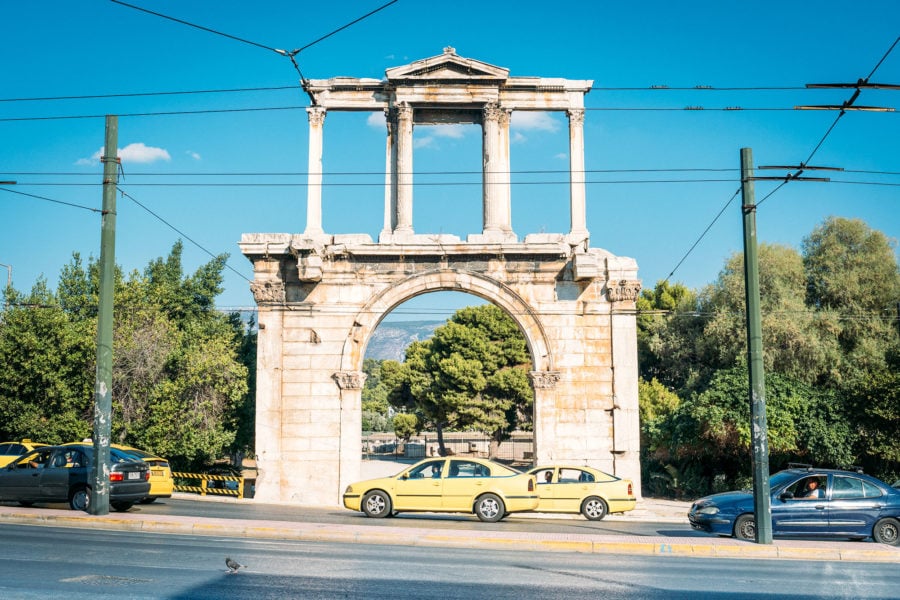
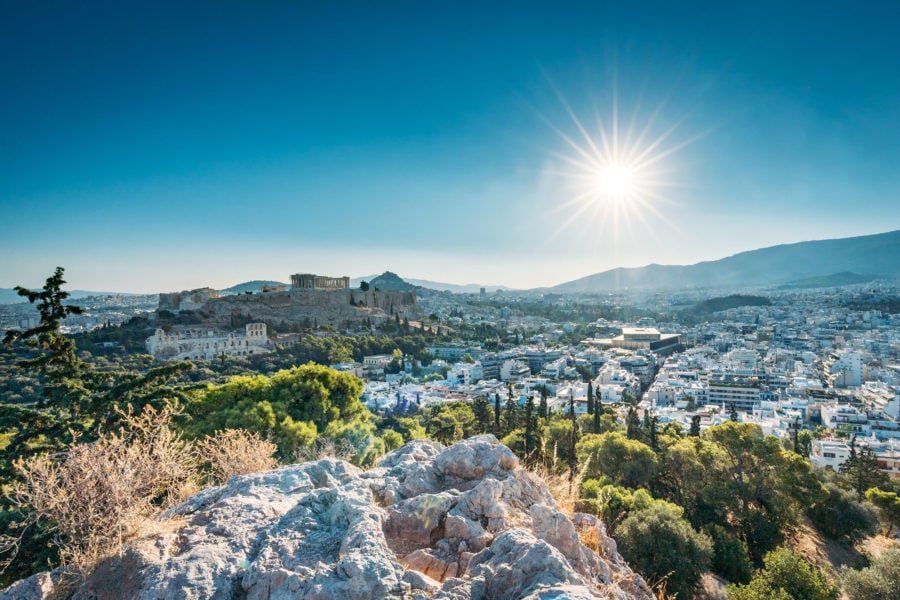
Declared an archaeological park in 1955-56, the 173 acre Philopappou Hill (or Filopappou Hill) is home to the Athenian owl, peregrine falcon and other indigenous birds. It also gives you great views of Athens from above! Probably why the birds like it so much.
The park includes the Hill of the Nymphs, the Pnyx, and the Mouseion Hill or Hill of the Muses where the Philopappou Mausoleum or Monument is located.
The Philopappou Mausoleum is dedicated to Gaius Julius Antiochus Epiphanes Philopappos, a prince of the Kingdom of Commagene who lived from 65 to 116 AD. His death caused grief to the citizens of Athens and the imperial family.
The 12th century Church of Demetrius Loumbardiaris hidden in wooded area of the park is perfect for a serene quiet visit.
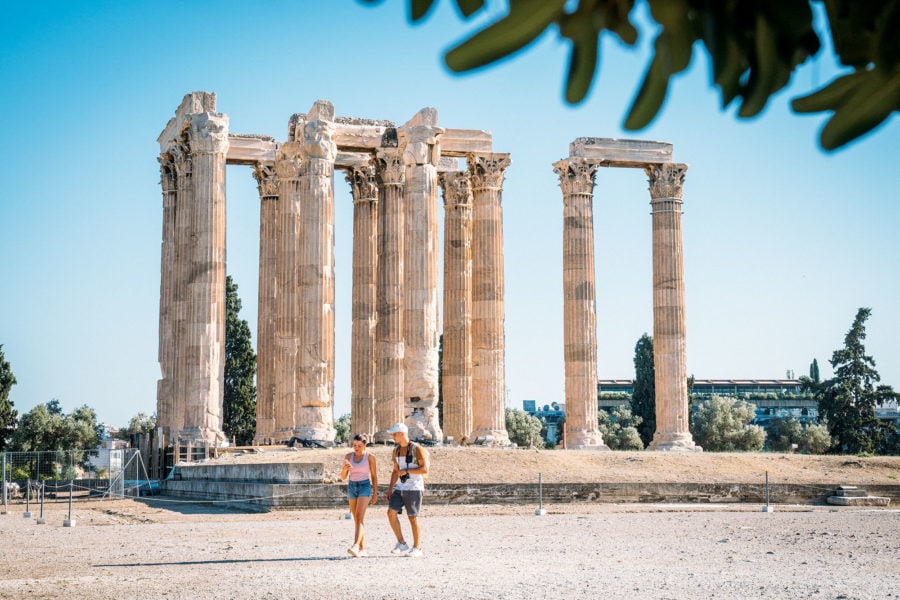
Among the oldest churches in the capital city of Athens, the Panagia Kapnikarea Church is a Byzantine treasure. Built in the 11th century on the ruins of a Greek temple, the church on Ermou Street near Monastiraki is dedicated to the assumption of the Virgin.
Illuminated by lamps instead of chandeliers, the walls feature mosaics and religious works of art.
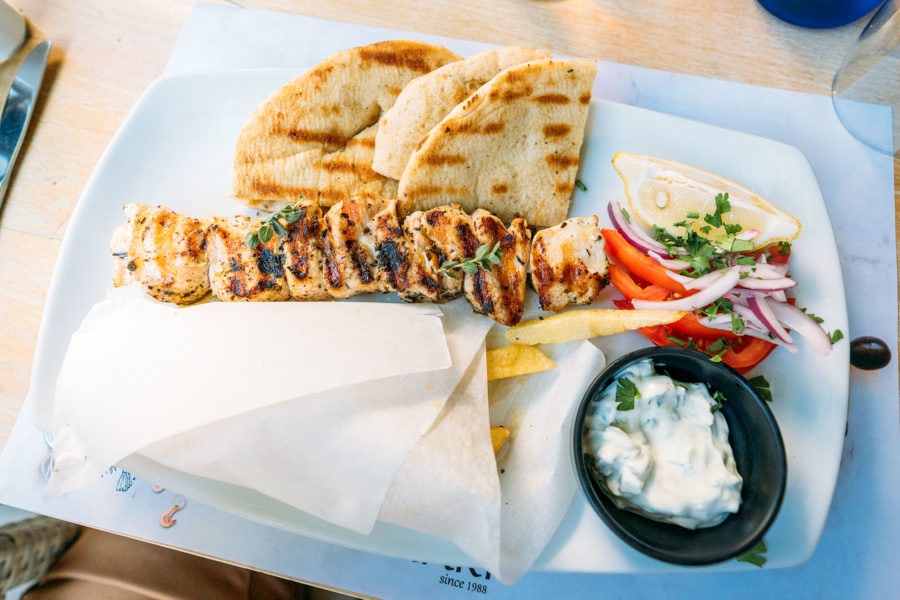
If you asked a local to point you to the best restaurants in Athens, everyone would point you towards a different one. There are just so many good tavernas and places to eat in Athens.
Make sure to check out some of the places on the Mnisikleous Restaurant Staircase, or the many tavernas in Plaka or Psiri Quarter. Old Ithaki is a good lunch spot we visited a few times, next to the Athens Cathedral.
But if you want to eat somewhere luxurious with a view of the city, try the the rooftop bar at the Grand Bretagne Hotel. Enjoy a cocktail here while watching the sun go down over Athens!
Established in 1986 by ship owner Nikolas Goulandris and his wife Dolly Goulandris, the Museum of Cycladic Art is located in the Kolonaki Quarter.
It houses over 3000 objects of art from the Cyclades, as well as Ancient Greek and Cypriot art. Most of these pieces are from Nikolas’ own collection and date back to the 4th to 6thcentury BC.

This 19th-century neighborhood on the Northern side of the Acropolis is a vibrant shopping area. Street vendors and shops sell trinkets and souvenirs, clothes, and specialty items to tourists. When you need a break, grab a bite at one of the many casual restaurants.
Situated close to many popular sites, the Monastiraki Flea Market in Monastiraki Square is the perfect place to buy souvenirs, handmade footwear, and artisanal products.
For a cool overhead view of the square and the city, make sure to visit the rooftop bar A For Athens and grab a cocktail!

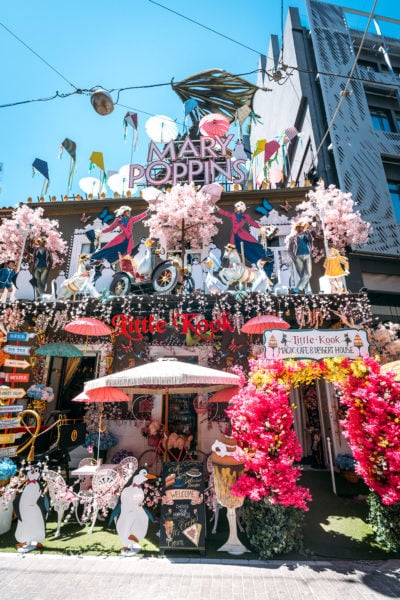
The Psiri Quarter (also spelled Psyrri or Psirri) is a hip and creative little neighborhood in Athens where all the happening nightlife is. You’ll find restaurants, bars, cafes, tavernas, and colorful street-art. One of the oldest neighborhoods in the city, it used to have a reputation for crime, but the area has been gentrified.
One place you need to stop here is called Little Kook Magic Cafe. This quirky coffee & cake place is decorated like a children’s fairy tale book, featuring all manner of animals, storybook characters, colorful flowers, dragons, fairies, and an umbrella covered side-street. The perfect Instagram photo location!
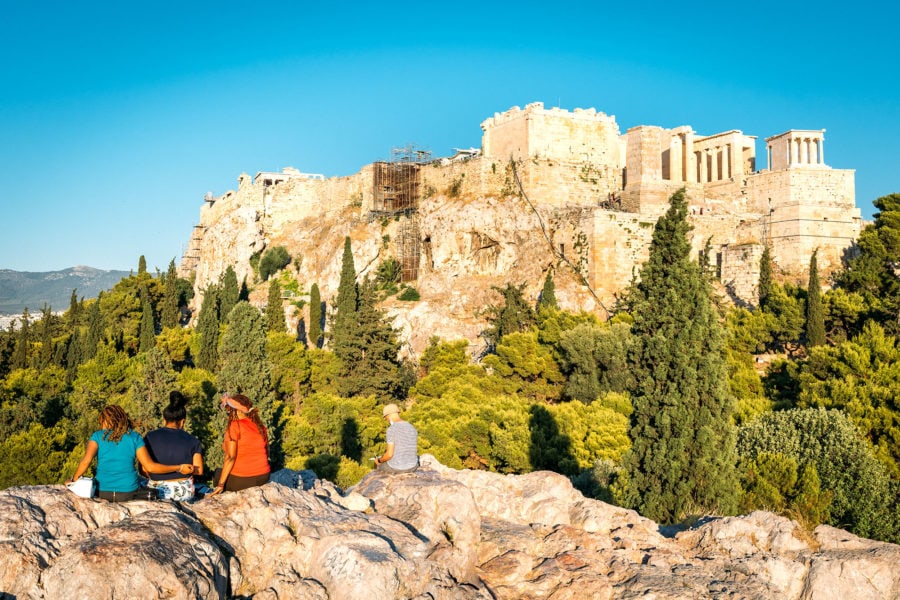
Areopagus Hill, also known as “Mars Hill”, is a large rock outcrop located close to the entrance of the Acropolis. Take the stairs up to the top of the rock for some awesome views of the Acropolis from a different perspective, as well as Athens itself.
The hill was an ancient meeting place where philosophy and law were discussed, as well as the location of a famous speech by St. Paul the Apostle. Sunset is a popular time to hang out up here!
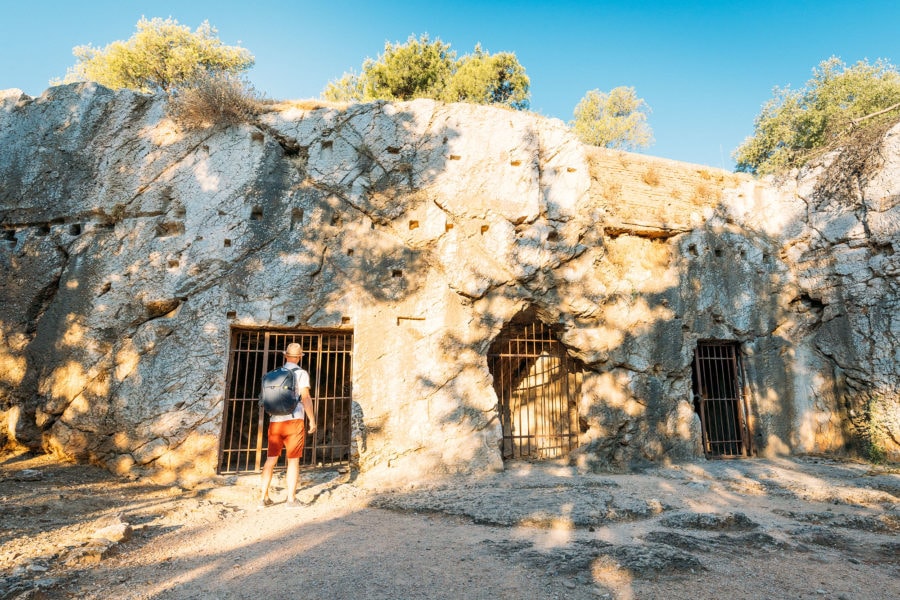
A cave-like structure cut into the Hill of Muses has long thought to have been the jail used to hold the ancient philosopher Socrates before he was executed. No one knows for sure.
The teachings of Socrates were thought of as dangerous in Athens, leading to the decline of morality in the population of Greece. A new Athenian democracy was afraid that citizens would stop obeying the established laws and rules or fulfilling their civic duty, which would lead to overthrowing of the new political system.
So Socrates was imprisoned, and eventually executed in 399 BC, by poison hemlock. The structure was also used as a place to hide antiquities from the Acropolis and the National Archaeological Museum during World War II.
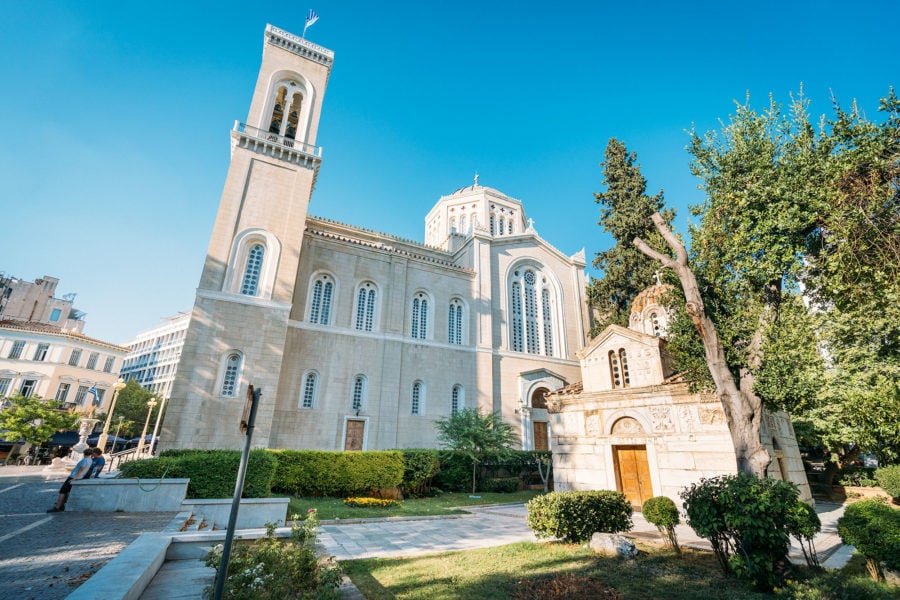
Church of the Virgin Mary – Byzantine-era church.
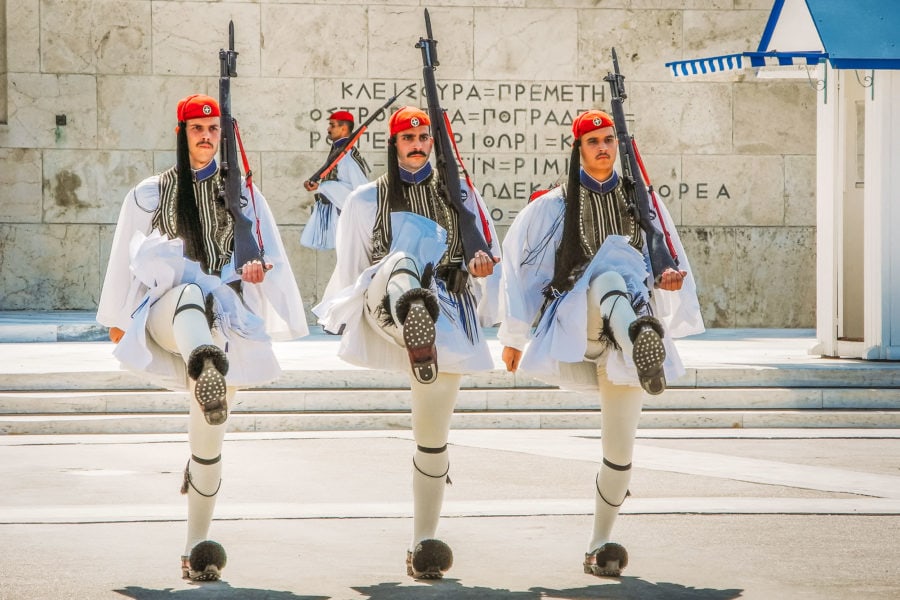
Dedicated to all lost Greek soldiers in past wars, Greece’s Tomb of the Unknown Solider sits in front of the Greek Parliament Building. Every hour, on the hour, you can watch the changing of the presidential honor guard.
This is a free thing to do in Athens, so it’s pretty popular and there’s often a large crowd watching. The Tomb, called a cenotaph, is empty and was made according to Ancient Greek custom.
A much more impressive ceremony takes place at 11am on Sundays, where a large group of Evzones (presidential guards) gather in front of the Parliament.
The best site to book your car is with Discover Cars. They search both local and international car rental companies to help you find the best possible price. This is the easiest way to rent a car and drive in Greece.
You’ll find taxis everywhere in Athens. Don’t go with drivers that bargain for prices. Make sure you catch a licensed taxi that has a meter and it’s switched on. You can choose from radio taxis, Uber, Taxibeat, or Taxiplon.
Although cycling in Athens wasn’t very popular earlier, it’s now catching on. You can rent bikes from Panorama Bikes, Athens Bikes, and Funky Ride.
The Athens Metro System is very easy to use, and has lines running from 5 AM to midnight. On Fridays and Saturdays, Lines 2 and 3 run till 2 AM.
Standard metro tickets worth €1.50 are valid on most trains, buses, and trams for a 90-minute journey. Day passes worth €4.50 and 3-day tourist tickets worth €22 are also available.
Accommodation in Athens can range from budget to luxurious. The best areas to stay are those close to the City Center, buses, restaurants and shops. Look for hotels or hostels located in Syntagma, Plaka, Monastiraki, or Koukaki.
| Travel Planning Resources For Athens |
|---|
| Packing Guide Check out my travel gear guide to help you start packing for your trip. Book Your Flight Ready to fly? Here’s how I find the cheapest airline flights. Rent A Car Discover Cars is a great site for comparing car prices to find a deal. Cheap Accommodation Learn how I save money booking hotels & vacation apartments. Protect Your Trip Don’t forget travel insurance! Protect yourself from possible injury & theft abroad. Read why you should always carry travel insurance. |
I hope you enjoyed my guide on the best things to do in Athens, Greece! Hopefully you found it useful. Here are a few more wanderlust-inducing articles that I recommend you read next:
Have any questions about things to do in Athens, Greece? What about other suggestions? Drop me a message in the comments below!
This is a post from The Expert Vagabond adventure blog.